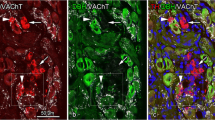Summary
A histochemical technique for the demonstration of catecholamines developed by Falck et al. has been successfully applied to the sympathetic chains of rats and mice maintained in vitro. Catecholamines were localized in the nerve fibers, showing identical green fluorescence as in tissue sections of healthy rats. The cultures 8 days in vitro exhibited positive reaction in a few terminals, whereas sister cultures 1 month in vitro showed strong fluorescence reaction in thicker proximal axons and networks of nerve fibers as well. Reactivity of neuron somas became positive after 1 month of cultivation. Application of reserpine in amount of 0.00025 mg/ml for 2 hours resulted in complete disappearance of fluorescence. Furthermore, cultures of spinal ganglia from fetal rat produced no fluorescence reaction with this technique. Therefore, the reaction is specific for sympathetic nervous tissue and reliable for the differentiation of sympathetic neurons from other types of nerve cells.
Similar content being viewed by others
References
Angelakos, T. E., and M. King: Histochemical demonstration of catecholamine uptake by adrenergic fibers. J. Histochem. Cytochem. 13, 282–286 (1965).
Bertler, A., B. Falck, and E. Rosengren: The direct demonstration of a barrier mechanism in the brain capillaries. Acta pharmacol. (Kbh.) (1963).
Carlsson, A., B. Falck, and N.-Å. Hillarp: Cellular localization of monoamines. Acta physiol. scand., Suppl. 196, 1–28 (1962).
Corrodi, H., u. N.-Å. Hillarp: Fluoreszenzmethoden zur histochemischen Sichtbarmachung von Monoaminen. 1. Identifizierung der fluoreszierenden Produkte aus Modellversuchen mit 6, 7-Dimethoxyisochinolinderivaten und Formaldehyd. Helv. chim. Acta 46, 2425–2430 (1963).
—: Fluoreszenzmethoden zur histochemischen Sichtbarmachung von Monoaminen. 2. Identifizierung der fluoreszierenden Produktes aus Dopamin und Formaldehyd. Helv. chim. Acta. 47, 911–918 (1964).
—, and G. Jonsson: Fluorescence methods for the histochemical demonstration of monoamines. 3. Sodium borohydride reduction of the fluorescent compounds as a specificity test. J. Histochem. Cytochem. 12, 582–586 (1964).
Dahlström, A.: Observation on the accumulation of noradrenaline in the proximal and distal parts of peripheral adrenergic nerves after compression. J. Anat. (Lond.) 99, 677–689 (1965).
Eränkö, O.: On the histochemistry of the adrenal medulla of the rat, with special reference to acid phosphatase. Acta anat. (Basel) 16, Suppl. 17, 1–60 (1952).
—, and M. Härkönen: Histochemical demonstration of fluorogenic amines in the cytoplasm of sympathetic ganglion cells of the rat. Acta physiol. scand. 58, 285–286 (1963).
—: Effect of axon division on the distribution of noradrenaline and acetylcholinesterase in sympathetic neurons of the rat. Acta physiol. scand. 63, 411–412 (1965).
Euler, U. S. v.: A specific sympathomimetic ergon in adrenergic nerve fibers (sympathin) and its relations to adrenaline and noradrenaline. Acta physiol. scand. 12, 73–97 (1947).
Falck, B., N.-Å. Hillarp, G. Thieme, and A. Torp: Fluorescence of catecholamines and related compounds condensed with formaldehyde. J. Histochem. Cytochem. 10, 348–354 (1962).
Fuxe, K., and N.-Å. Hillarp: Uptake of L-dopa and noradrenaline by central catecholamine neurons. Life Sci. 3, 1403–1406 (1964).
Hamberger, A., and B. Hamberger: Uptake of catecholamines and penetration of trypan blue after blood-brain barrier lesions. Z. Zellforsch. 70, 386–392 (1966).
Hamberger, B., T. Marforms, K.-A. Norberg, and Ch. Sachs: Uptake and accumulation of catecholamines in peripheral adrenergic neurons of reserpinized animals, studied with histochemical method. Biochem. Pharmacol. 13, 841–844 (1964).
—, and Ch. Sachs: Standardization of paraformaldehyde and of certain procedures for the histochemical demonstration of catecholamines. J. Histochem. Cytochem. 13, 147 (1965).
Härkönen, M.: Carboxylic esterase, oxidative enzymes and catecholamines in the superior cervical ganglion of the rat and the effect of pre- and post-ganglionic nerve division. Acta physiol. scand., Suppl. 237, 1–94 (1964).
Hodgman, C. D.: Constant humidity with sulfuric acid solutions. In: Handbook of chemistry and physics, 41 ed., p. 2500. Cleveland: Chemical Rubber Publishing Co. 1959.
Vogt, M.: The concentration of sympathin in different parts of the central nervous system under normal conditions and after the administration of drugs. J. Physiol. (Lond.) 123, 451–481 (1954).
Author information
Authors and Affiliations
Additional information
This work was supported by research grant NBO 3173 from the National Institute of Neurological Diseases and Blindness, U.S. Public Health Service, and research grant No. 355 from the National Multiple Sclerosis Society, New York.
Rights and permissions
About this article
Cite this article
Sano, Y., Odake, G. & Yonezawa, T. Fluorescence microscopic observations of catecholamines in cultures of the sympathetic chains. Zeitschrift für Zellforschung 80, 345–352 (1967). https://doi.org/10.1007/BF00339327
Received:
Issue Date:
DOI: https://doi.org/10.1007/BF00339327




